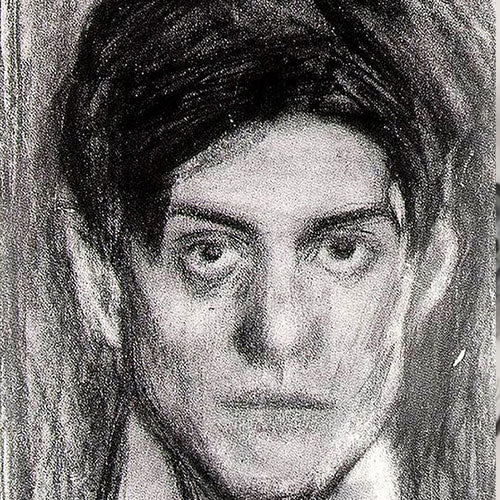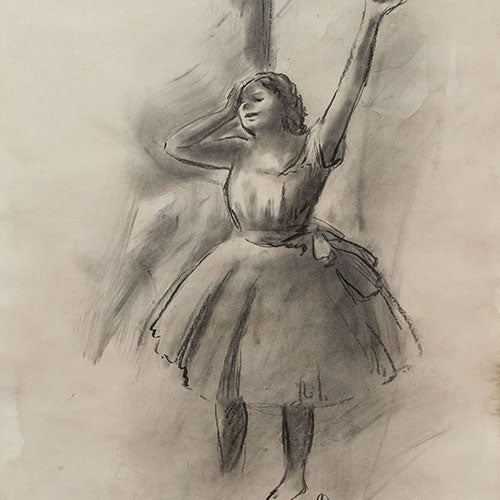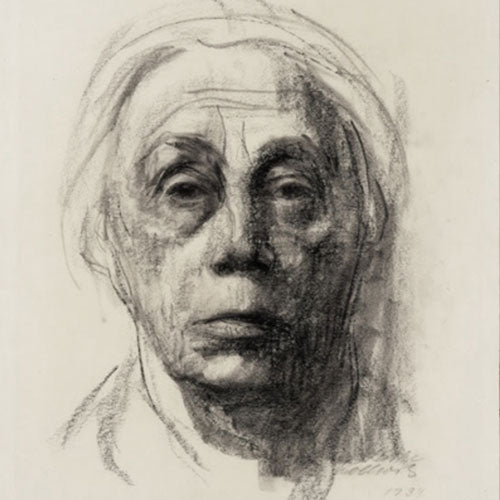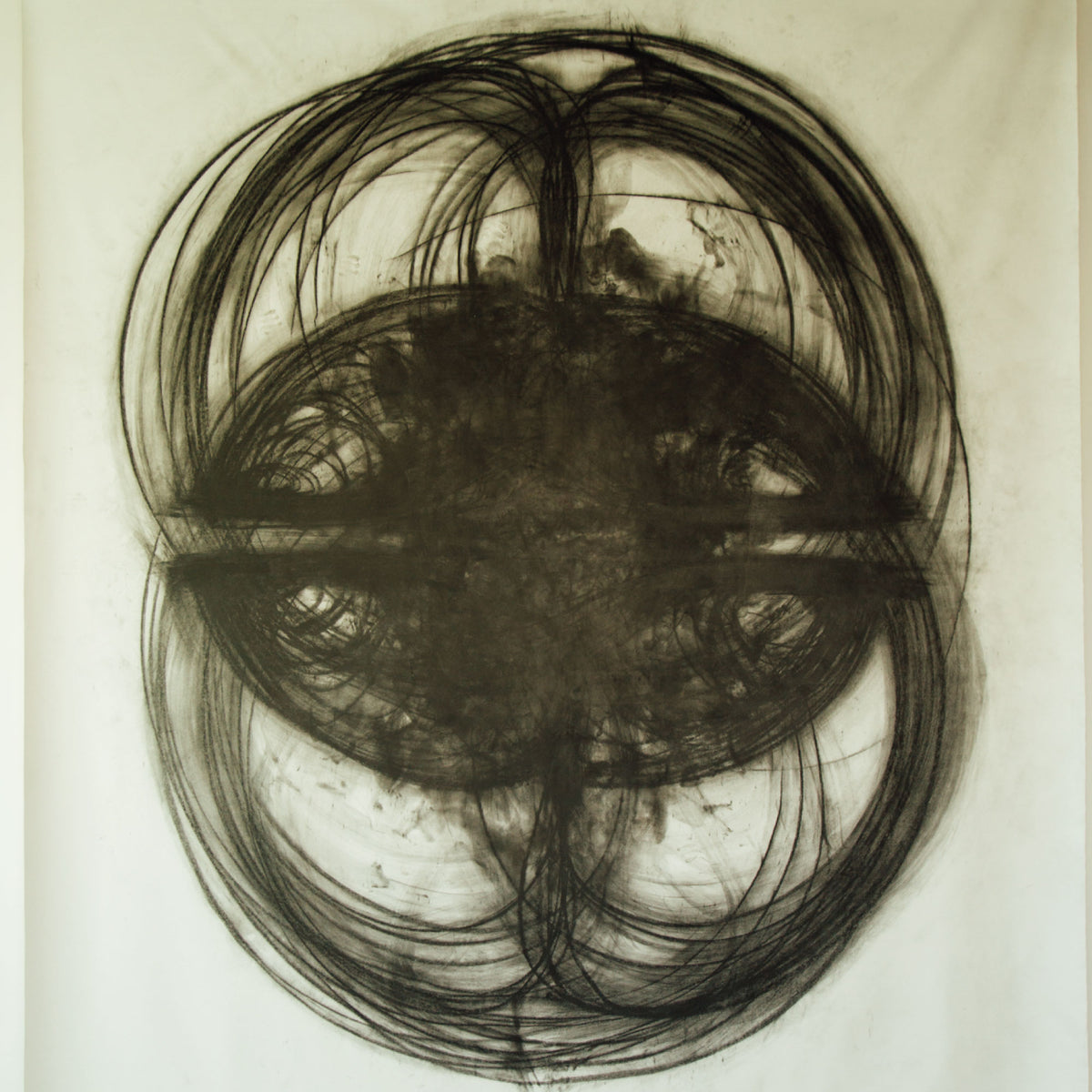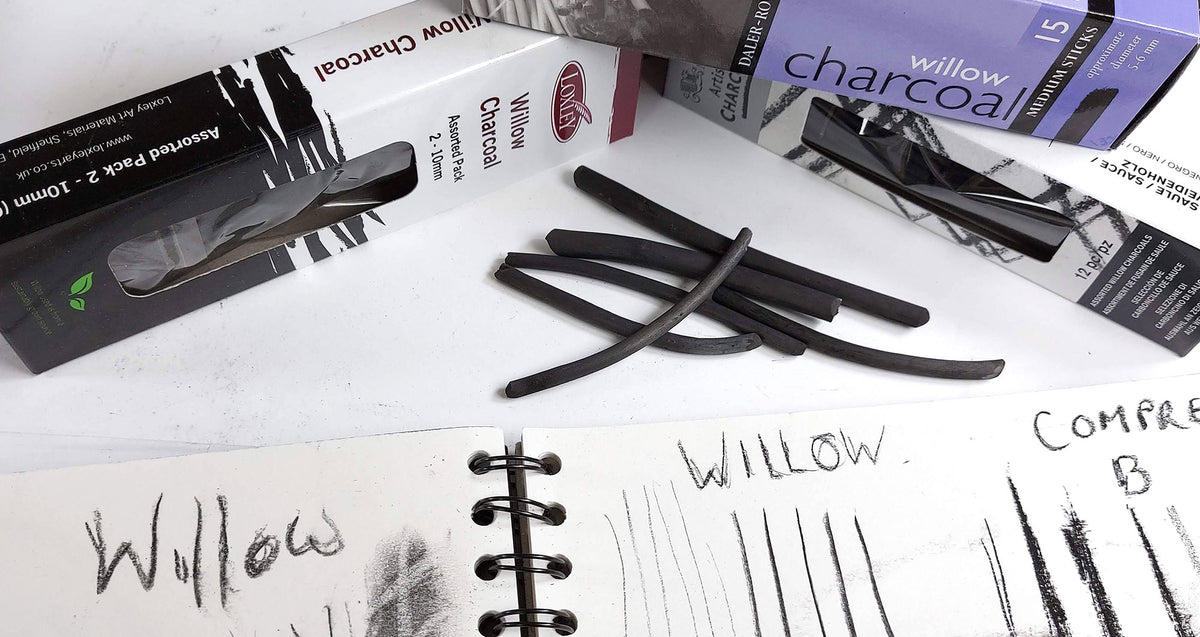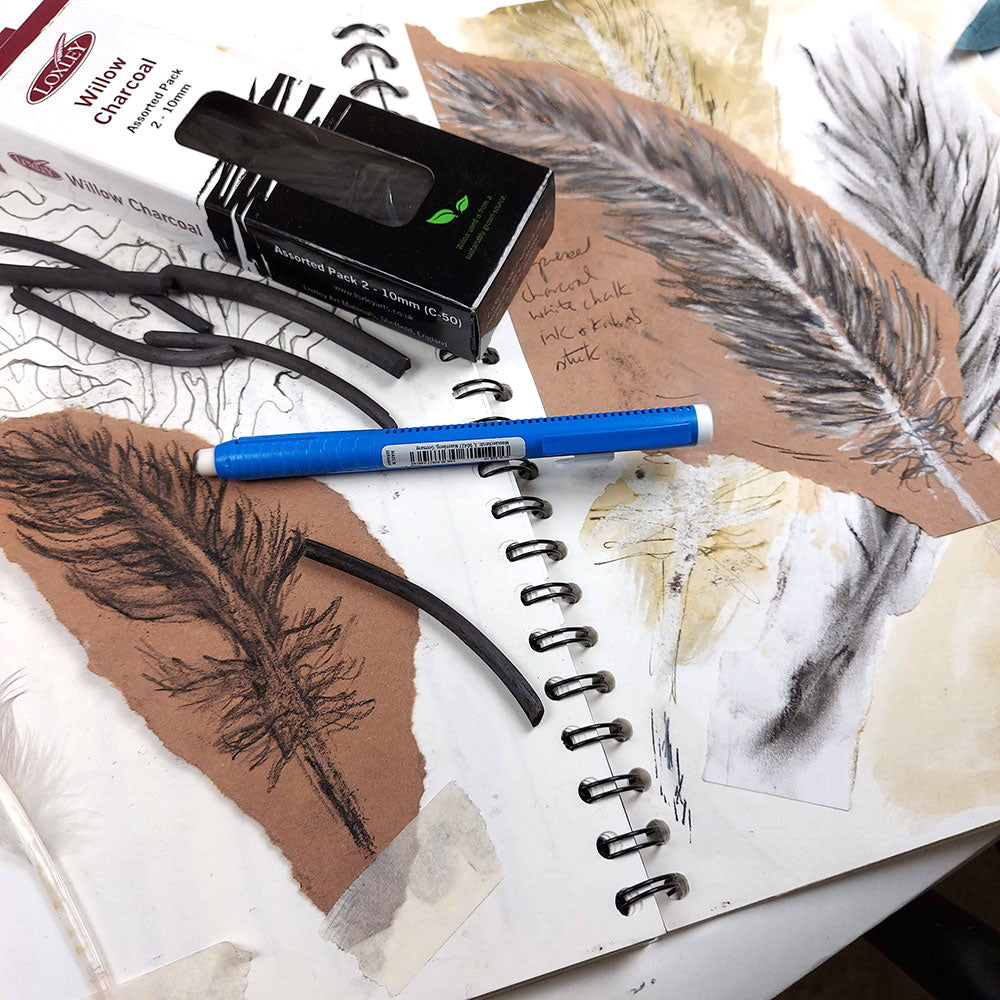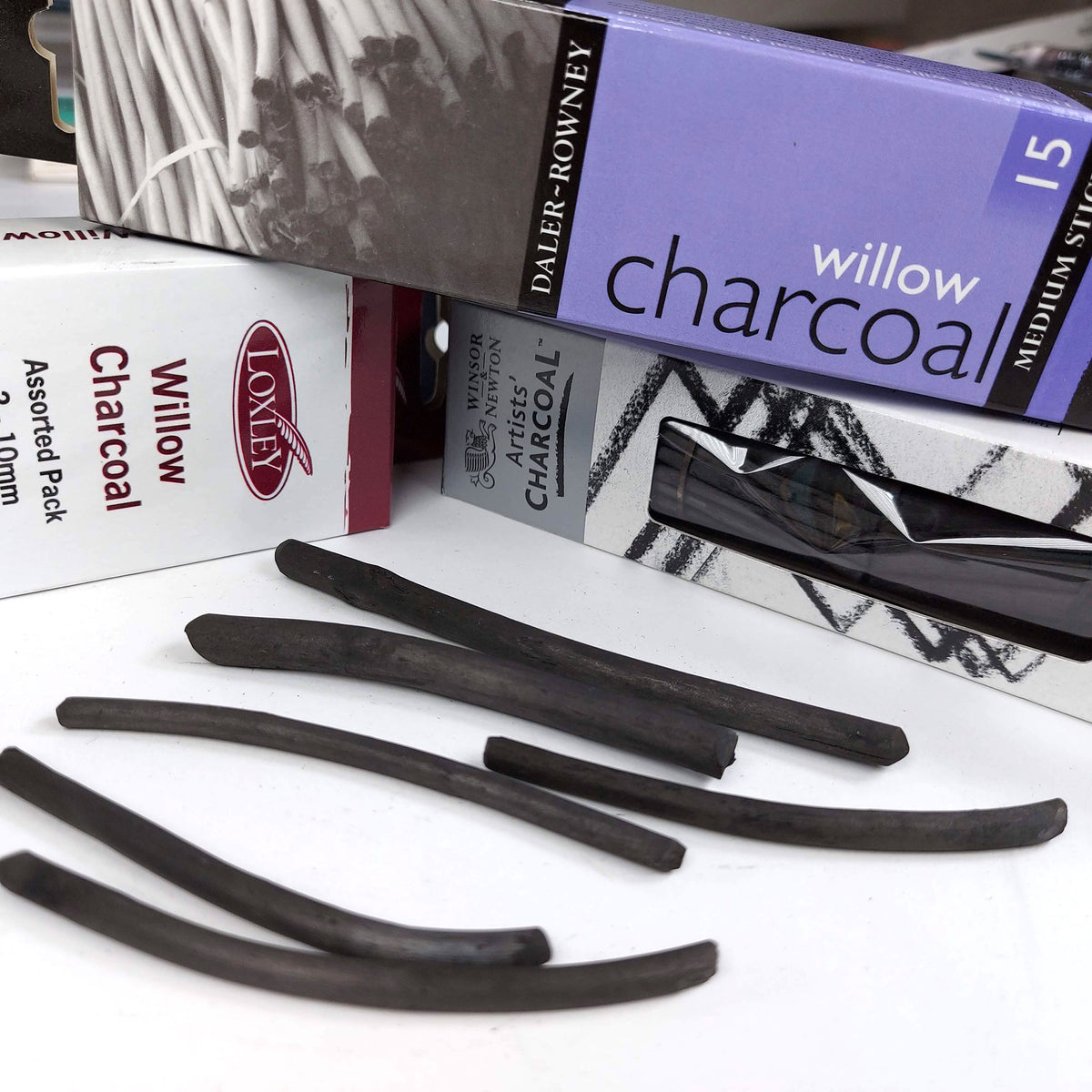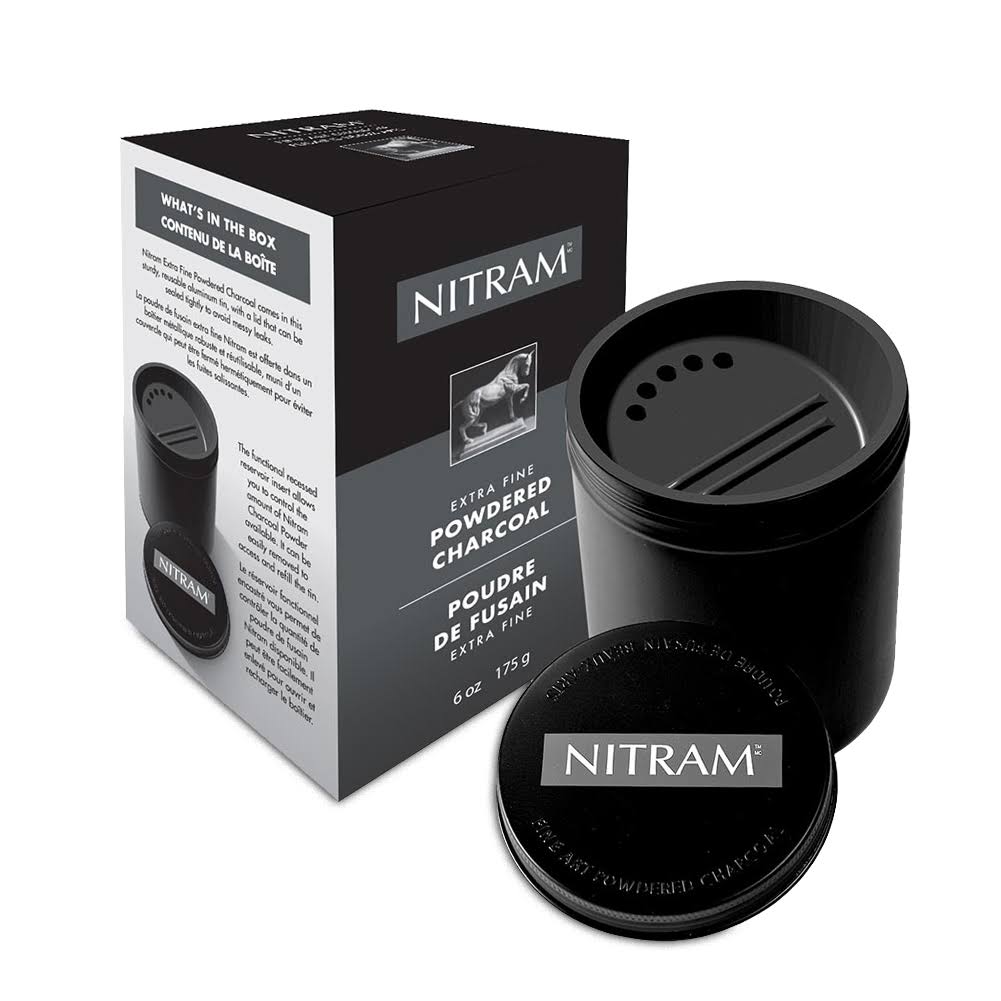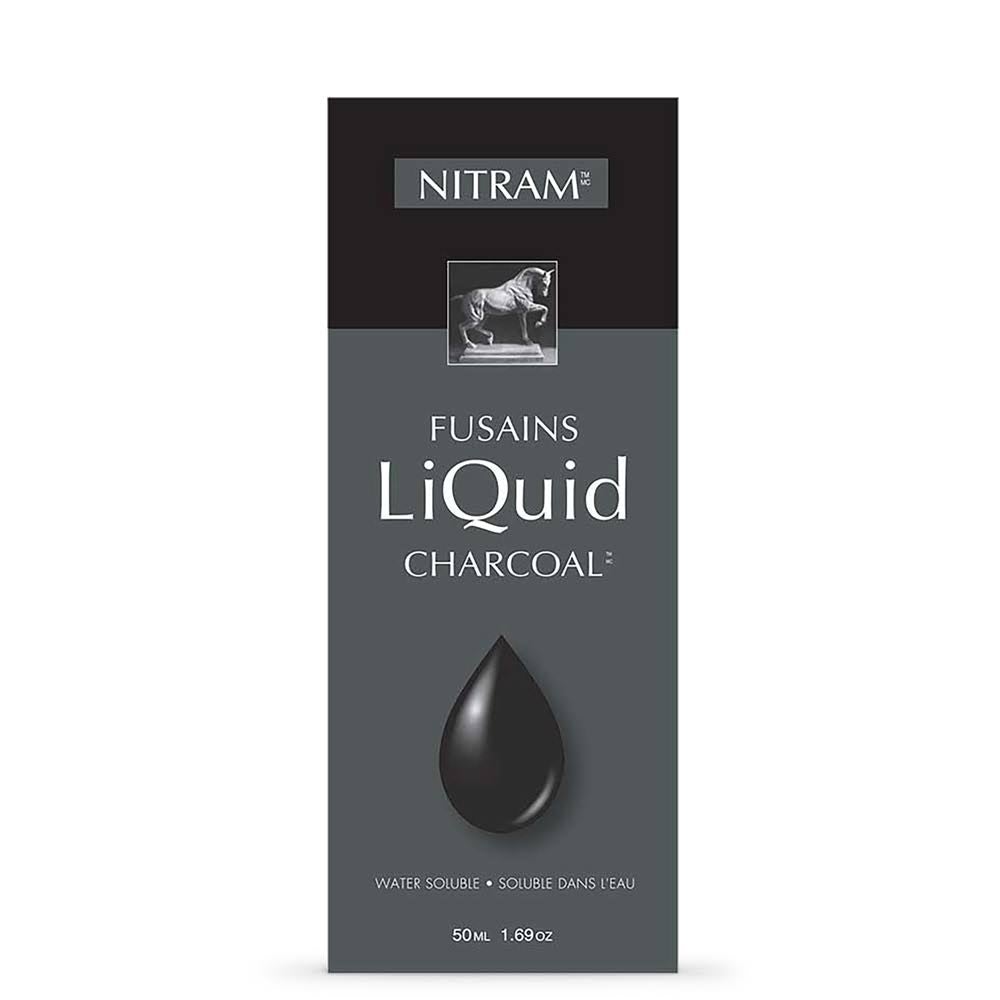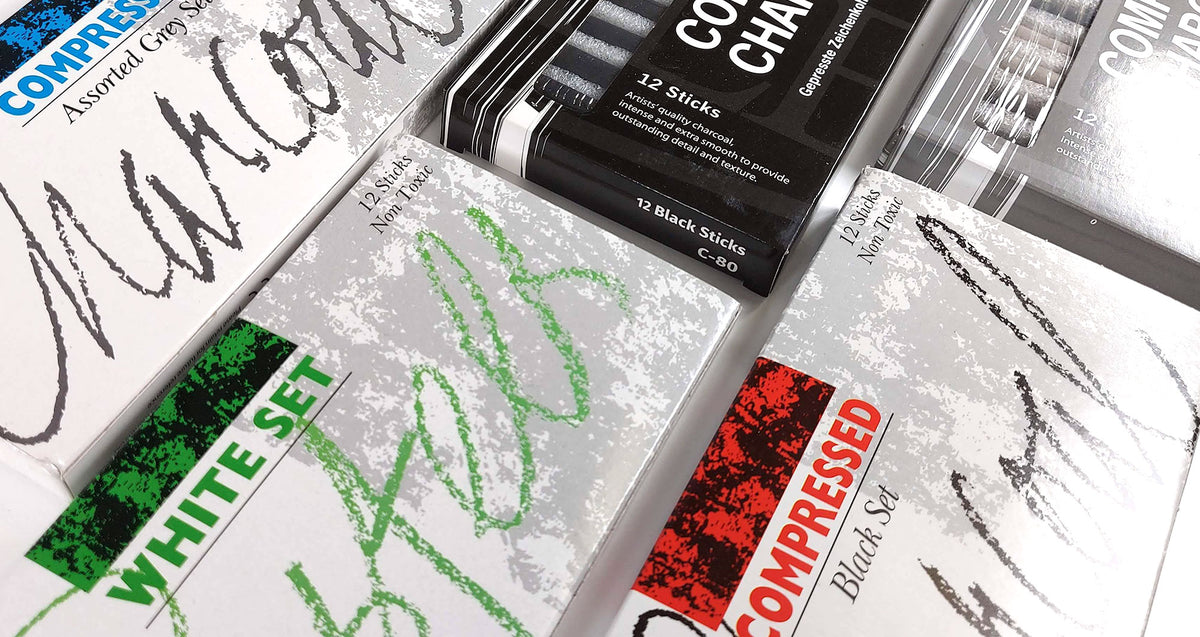Your Cart is Empty
An Artists' Guide to Charcoal
Compressed charcoal was developed in the 20th century to strengthen the natural structural weakness of Willow and Vine charcoal. To create compressed charcoal or charcoal pencils natural gum or wax binder is added to powdered charcoal. This makes the charcoal stronger to draw with and produce less dust. Many grades of this compressed charcoal can be found in stick forms or in the form of charcoal pencils.
Charcoal has been and is still used by many fine artists, illustrators, and performing kinetic artists. There are many types of charcoal on the market today that can be used to create illustrations, sketches, finished drawings, used to lay out a painting on canvas, or work on large scale pieces and during performance art. Many students of Art & Design have started their creative journeys using black charcoal during their introductory drawing classes. A perfect tool for investigating both line and form and for exploring light and contrast!.
6 influential Charcoal artists throughout Art History
Many notable artists have used charcoal in many different ways to suit their particular styles and studies;
Vincent van Gogh was often drawn to studying ordinary hard working farmers and their families. Charcoal was a medium he often used for working onsite in the fields. The immediate nature of charcoal enabled Vincent to illustrate their emotions and fatigue through their weighted body language.
This study of a kneeling nude is a clear example of how Picasso's style changed during the first decade of the 20th century from naturalist figures to strongly muscular forms influenced by African masks and African sculpture. This charcoal drawing is a study for the leftmost figure in Picasso’s large painting Three Women (1907–8) an important work in the artist’s development of Cubism.
Käthe Kollwitz was a master of creating drawings that depicted the broken and emotional states of mankind. Similar to Vincent van Gogh, she was an empath and had intense compassion for the working class and downtrodden. Her beautiful charcoal drawings describe with minute detail the suffering and grief experienced by her sitters, combining techniques with feeling, soft transitions turning into dark black spaces at atmospheric landscapes.
Heather Hansen is a kinetic performance artist who uses her whole body with movement to generate one of a kind symmetrical charcoal drawings on a large scale. Pushing quite literally the boundaries of drawing and movement. Hansen has performed across the United States and Europe as well as Asia. For more information visit Heather's website here.
Characteristics of Charcoal.
Charcoal is an odourless, dry, lightweight, black substance, in the form of porous solid or powder. Charcoal produces a matt dark grey or black line on the surface with softer edges and depending on what type of charcoal you use, the mark you make can range from a very dark intense black to a light grey with many shades in between. Charcoal is an incredibly easy medium to use and is an excellent medium for all abilities, providing a wide tonal range within the same stick or pencil. See below the list of different charcoal products. Tinted Charcoal is also available in both the sticks, blocks, pencils and now even water-soluble paint pans.
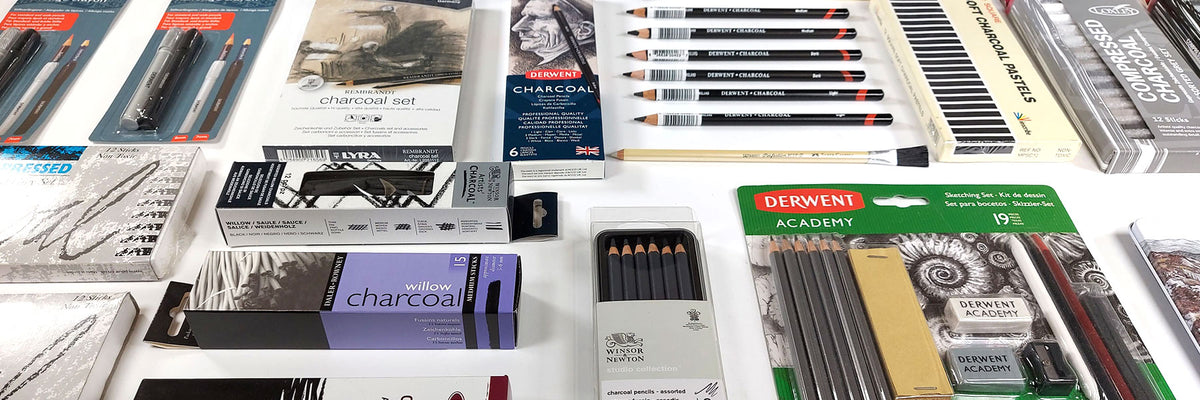
Willow and Vine Charcoal
Willow and Vine charcoal are incredibly brittle and come in assorted lengths. They do not contain any binder so are very smooth during application and can easily be erased. They may need a fixative to secure the drawing onto the paper, but be aware that this will darken your work slightly. Willow and Vine charcoal provide a medium to light grey line but aim to test a few different brands as they may differ slightly in colour and tone.
Willow Charcoal Assorted Short lengths

Willow Charcoal Artists Assorted 2-10mm - 30 sticks of charcoal for sketching and drawing.Use with cartridge paper, pastel paper and even on canvas.
View productArtists' Willow Charcoal - Assorted

Specially prepared for artists’ use, the wood used for our willow charcoal is correctly baked to produce an even line of consistent intensity. Capable of very fine lines as well as broad bold strokes.
View ProductDaler Willow Charcoal - Medium 15 Sticks

Renowned as the world's finest willow charcoal, tried and trusted traditions are combined with innovative production techniques and environmental concerns to produce Daler-Rowney's willow charcoal sticks.
View ProductPowdered Charcoal
Powdered Charcoal is finely milled Willow or Vine charcoal. You can apply this fine charcoal dust with either a brush or a piece of fabric rag or soft paper towel. Blending the powdered charcoal on paper can create large areas of atmospheric perspective or soft focus backgrounds.
Nitram Extra Fine Powdered Charcoal is milled to an extra fine, uniform 100μ particle size. It is smooth, velvety and very high-quality. It has no coarse or grainy lumps that will mar the surface of your paper, ensuring a consistent finish.
You can use a brush or a paper stump to create shapes and tones quickly and easily. Nitram Powdered Charcoal comes in a sturdy, reusable aluminium tin with a lid that can be sealed tightly to avoid messy leaks.
It has a functional recessed reservoir insert that allows you to control the amount of Charcoal Powder available. It can be easily removed to access and refill the tin. Please note: a dust mask is highly recommended during use.
View ProductLiquid charcoal
Liquid charcoal provides a unique way to work with charcoal. Liquid Charcoal is water soluble, so you can adjust the values from very light to a deep, rich black. This versatility opens up a broad spectrum of textures, giving artists a new way to work with sketch-like applications. Straight out of the tube it is as thick as oil paint, allowing you to draw with a brush or even use a palette knife to apply it. Nitram Liquid Charcoal dries very quickly and has excellent lightfastness. It can be used wet or dry.
Nitram Liquid Charcoal provides a unique way to work with charcoal. Liquid Charcoal is water soluble, so you can adjust the values from very light to a deep, rich black. This versatility opens up a broad spectrum of textures, giving artists a new way to work with sketch like applications. Straight out of the tube it is as thick as oil paint, allowing you to draw with a brush or even use a palette knife to apply it. Nitram Liquid Charcoal dries very quickly and has excellent lightfastness. It can be used wet or dry.
Ingredients:Water, gum arabic, Nitram Powdered Charcoal, hydroxyethyl cellulose, talc, aminomethyl propanol, ethylparaben.
View ProductCompressed Charcoal and Tinted Charcoal Blocks
Compressed charcoal are hard brittle sticks made from charcoal powder and a binding agent – usually a natural gum or wax. This mixture of charcoal powder and binder is then shaped into a mold, to create a stick form. These sticks can be held like a pencil or like a crayon and all parts can be used to create a mark. For a fine line you can use the tip, or side of the charcoal. For a broader mark, you can use the whole side of the charcoal to block out areas. Some of the moulded compressed charcoal sticks come in a cylinder shape or some can be found with square shaped sides. They are much stronger than the thinner Willow or Vine charcoal sticks. They also come in various grades from hard to soft.
Derwent XL Charcoal blocks combine the natural qualities of charcoal with the strength and body of a chunky block.There are 6 colours in the range: 1 natural black, 4 traditional drawing colours and white.
Inscribe Soft Charcoal Pastels

These square shaped soft pastels are ideal for block colouring and detailed work.
View productJakar Compressed Charcoal Sets

Jakar Compressed Charcoal Assorted Grey and Black set - 12 non-toxic compressed charcoal sticks.
View ProductLoxley Compressed Charcoal Sets
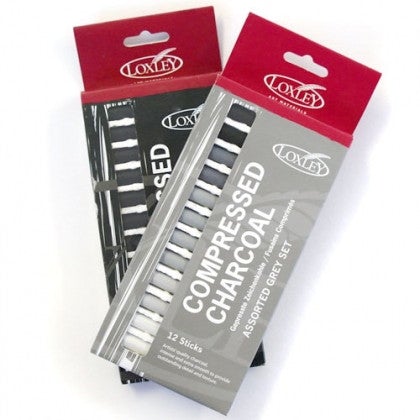
Loxley Compressed Charcoal is a set of 12 compressed artists' quality charcoal sticks.
View ProductConte 12 Compressed Charcoal Sticks
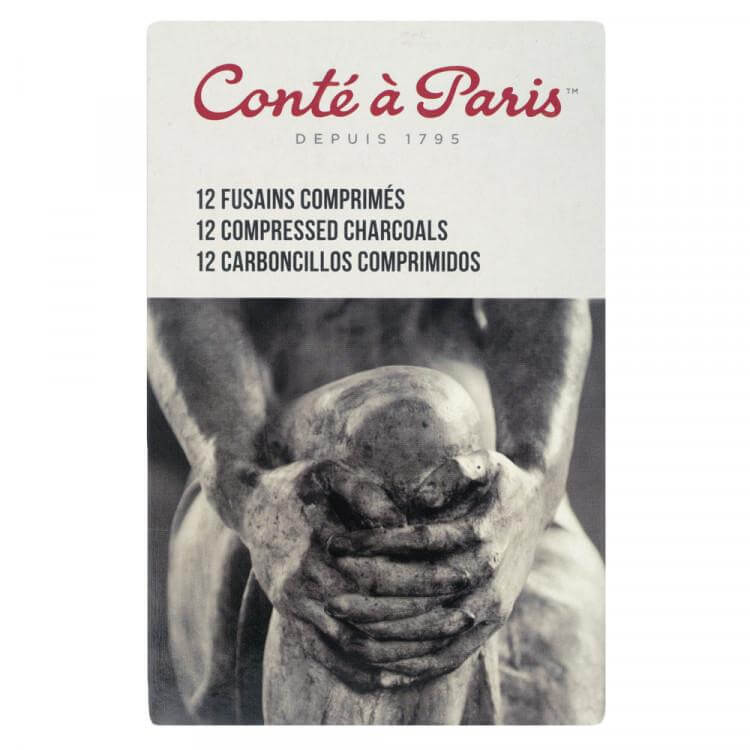
Ideal for drawing and sketching. Can be used with natural charcoal to obtain clean lines. Can be blended using fingers or a paper stump and is erasable with a soft eraser.
View productDerwent XL Charcoal Blocks
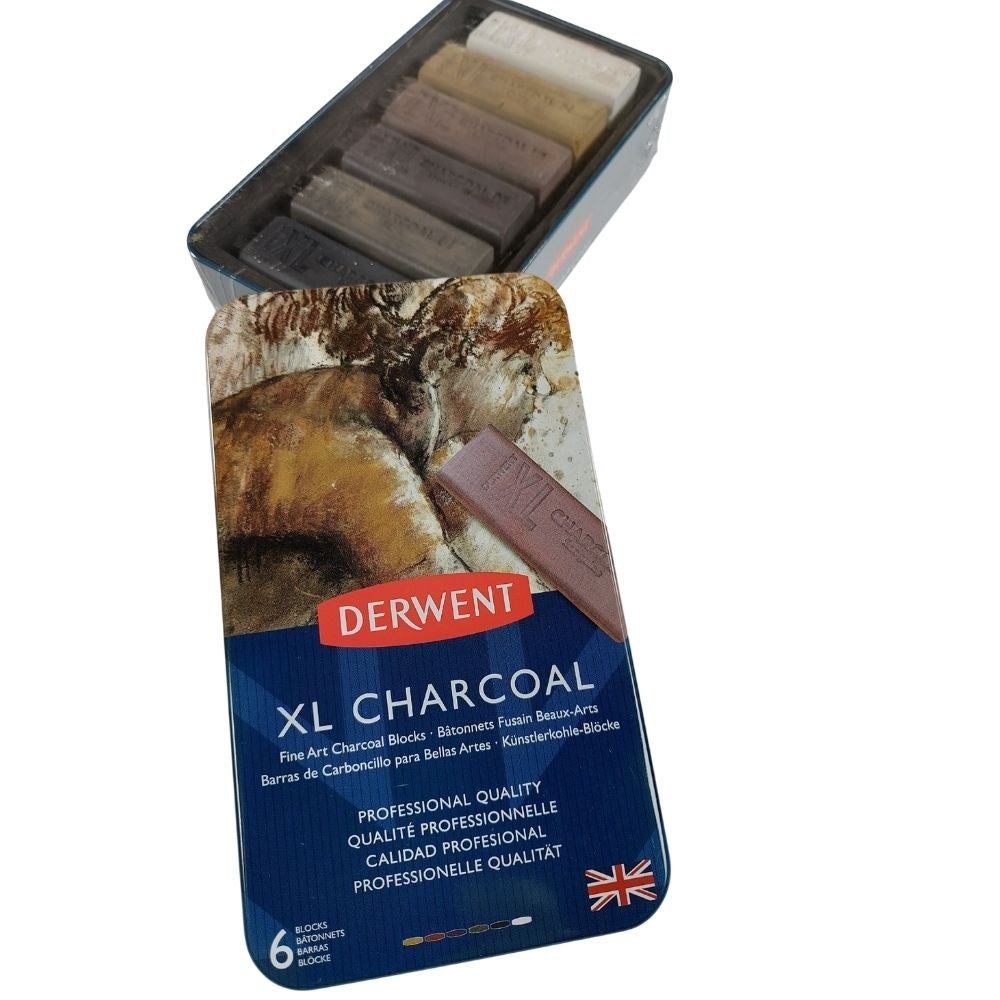
From powerful lines, to subtle gradients, Derwent XL Charcoal combines the natural qualities of charcoal with the strength and body of a chunky block.
View ProductCharcoal Pencils
Charcoal Pencils are similar to the compressed charcoal sticks and blocks, in that they are made from charcoal powder and binder. The only difference being they are in a pencil format. And just like compressed charcoal they usually come in a range of grades from hard to soft. They provide more scope for achieving small and detailed work whilst still using a traditional charcoal medium.
The tinted charcoal pencils offer the dramatic beauty of charcoal with a gentle hint of colour. Natural charcoal particles and a small amount of colour pigment are combined with the finest clays then encased in wood to produce a wonderfully expressive drawing tool. Derwent tinted charcoal individual pencils are available in 24 fabulous shades, including white for highlighting, the colours smudge and blend beautifully to produce deep, rich tones.
Derwent Tinted Charcoal Pencils

Derwent Tinted Charcoal offers the dramatic beauty of traditional charcoal with a gentle hint of colour. Natural charcoal particles and a small amount of colour pigment are combined with the finest clays then encased in wood to produce a wonderfully expressive drawing tool.
Derwent Charcoal Pencils Set of 6

Five easy to use charcoal pencils and a white pastel pencil, ideal for rich, dramatic drawings.
Contains:
5 Charcoal pencils (1 light, 2 medium and 2 dark)
1 White pastel pencil
Free sharpener
Conté à Paris Charcoal Pencils - Singles
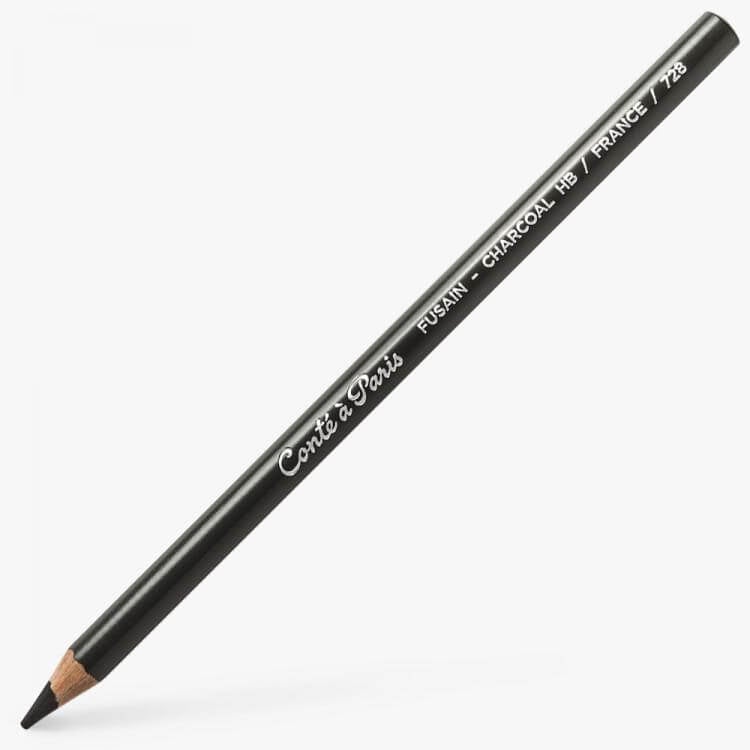
The Conte Charcoal pencil gives a clean, dense finish of intense black.
This pencil blends perfectly with the iron red and sepia pencils and allows you to produce more accurate and carefully drawn lines than traditional charcoal it also does not dirty your hands.
Charcoal Sets
Charcoal Sets provide a great starter kit for the beginner.
Some of the sets and kits listed below include an invaluable kneadable eraser and a blender!
Faber-Castell Charcoal Sketch Set

Charcoal starter set for hobby artists.
Contains: 2 Pitt natural charcoal sticks (6 - 11 mm), 1 Pitt charcoal pencil medium, 1 Pitt pressed charcoal pencil soft, 1 Pitt Pastel pencil white medium, 1 kneadable eraser, 1 paper wiper
Derwent Charcoal Set

Perfect for life studies and expressive pieces; this charcoal collection has been specially selected to include a comprehensive range of charcoal media .
View ProductDerwent Tinted Charcoal Pencil Sets
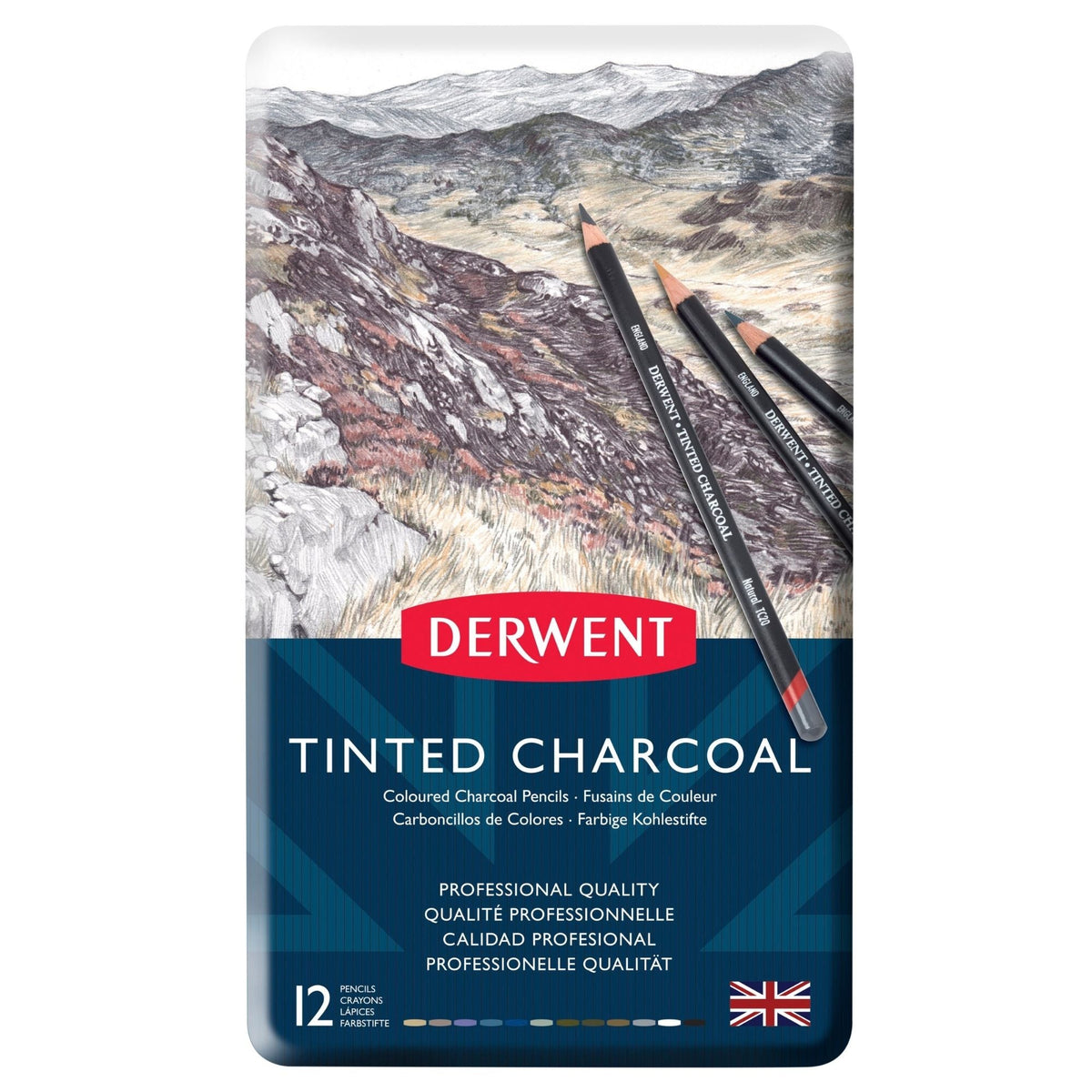
Derwent Tinted Charcoal offers the dramatic beauty of traditional charcoal with a gentle hint of colour. Natural charcoal particles and a small amount of colour pigment are combined with the finest clays then encased in wood to produce a wonderfully expressive drawing tool.
View ProductLyra Rembrandt Charcoal Set

This fantastic set is perfect for sketching and fine art. It contains an assortment of quality charcoal pencils with a 5mm lead and a range of charcoal sticks and carbon pencils.
View productFaber-Castell Pitt Charcoal - Set of 24
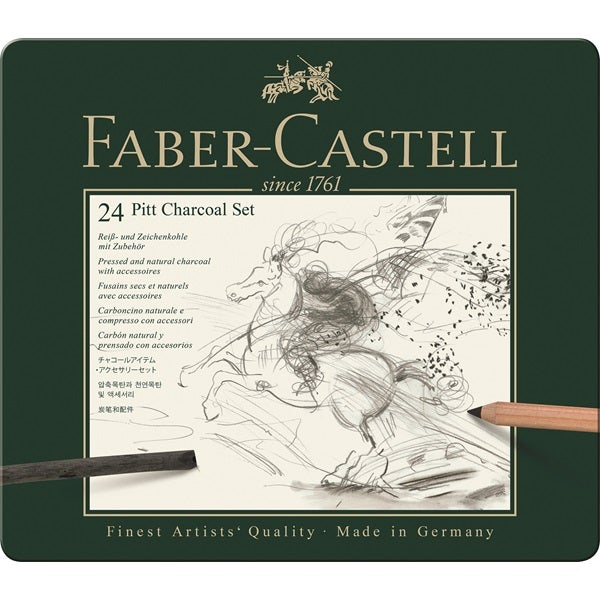
Natural charcoal sticks are the oldest sketching and drawing material in the world. The greyish-blue shade glides softly across the paper, rubs and smudges easily, and can be erased without difficulty and repeatedly overlaid.
View ProductTechniques and tips using charcoal in art.
Tips for drawing with charcoal
Charcoal is an incredibly easy and versatile medium to use, however there are some precautions you could take to make it a more successful experience and some techniques you can use to achieve the results you want.
Charcoal and graphite are generally a non-toxicmedium unless large quantities are consumed or inhaled. Charcoal does crumble more easily than graphite and may leave a lot of dust on the paper. If you are particularly sensitive to dust or if you are proceeding with a large charcoal drawing, it may be useful to wear a dust mask so as not to inhale the small dust particles. If you are working with charcoal powder it is highly recommended that you wear a dust respirator or a dust mask.
Don’t blow the dust away, lift your artwork and tap!
Whilst working, aim to lift your drawing from time to time to let the dust fall onto a damp towel or mat. Don’t be tempted to blow your dust away as you may inhale the dust rather than blowing it away. You could also gently brush the dust away with a soft brush. The amount of dust produced all depends on the pressure you use and the repeated strokes you use plus the softness of the charcoal. If this is your first time using charcoal, tread lightly, too much pressure and you will go too dark too soon! Too much charcoal cannot be easily erased or softened. Aim to work with a willow charcoal before working with compressed charcoal. You can also capitalise on this excess dust and work it into your drawing to create an atmospheric perspective or soft focus background!
Wear protective clothing
Charcoal dust will fall everywhere if you are working quickly or in large format. Some artists don’t mind the feel of charcoal on their hands but it can irritate skin. Others choose to wear protective clothing. Gloves can be worn to stop the fine dust particles becoming ingrained in your hands, and aprons can be worn to protect your clothing. Charcoal will wash out in the wash on almost all fabrics.
Charcoal Drawing Techniques
Light and dark mark making with charcoal
To create a lighter tone or line, use Willow or Vine charcoal, especially if you are not familiar with the technique. If you want to try compressed charcoal, use a light touch on the paper using a grade ‘B’ or a grade ‘2B’.
To create dark areas within your composition aim to use a soft ‘4B’ or ‘6B’ compressed charcoal with a slightly heavier pressure on the paper, but don’t go too dark too soon. Working over your drawing in layers will also darken your composition where it is needed, this will also help to control the degrees of value you are creating. Aim to work light to dark in stages.
Creating texture with charcoal
Creating texture with charcoal can be achieved in many ways. Using a kneadable eraser will allow you to pull the charcoal off the paper. Before you use your kneadable eraser, warm it up in your hands and shape it to any shape you want, either drag it over the charcoal or push down then pull up. A block eraser will provide a much more precise or sharper line or mark as it is harder. A Faber Castell Eraser Pencil Perfection 7058B with Brush or a Staedtler Mars Plastic Eraser Holder & Refill pen eraser will also allow much more specific control when creating marks.
Water can be brushed over the charcoal to create a direct mark or sprayed onto your charcoal drawing to create more of an organic texture. Once your charcoal is dampened, it is then harder to erase but you can still work into it and on top of it whilst wet or dry. Applying water will darken the charcoal considerably but can provide very effective finishes.
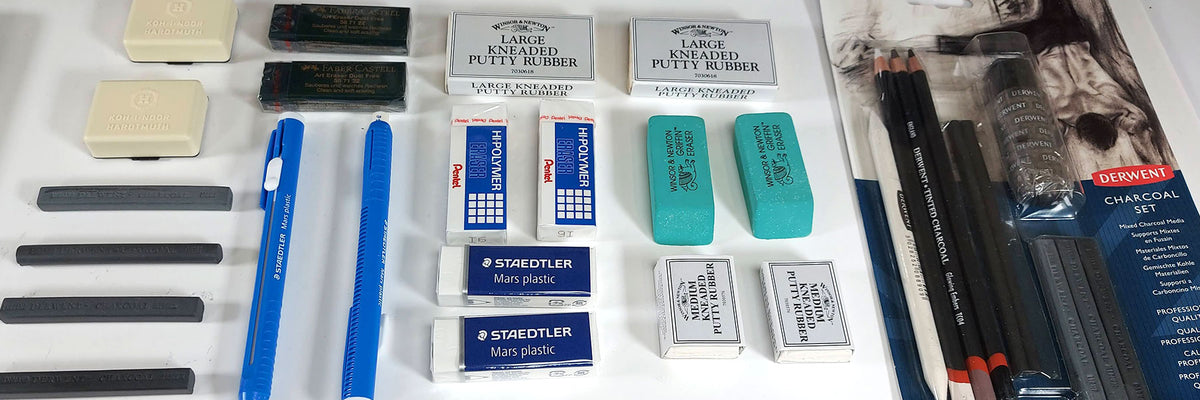
Blending and creating tonal gradation with charcoal
Blending charcoal to create a gradient or to create a softer look can be achieved by using paper stumps or Tortillions. A soft fabric rag, or a soft paper towel can also be used. Small areas within a drawing can be blended by using the tip of your finger or a cotton bud.
Seamless gradations can be created by working over areas using a soft cloth in a circular motion, gradually building the tones from light to dark, layer upon layer. The powdered charcoal is also great for toning a whole surface area before you compose your drawing. Having a mid ground speeds up your drawing time considerably.
Creating soft and hard edges with charcoal
Soft and hard edges within your composition can be created by simply using the straight edge of a piece of paper or card. A soft edge can be created by blending using a soft cloth brush or your hand and by tearing the edge of a piece of paper then using powdered charcoal on a cloth over the edge
Using Charcoal on toned paper and other surfaces
Charcoal is mostly used on paper but can be used on most other surfaces such as canvas, wooden panels, cardboard, and toned paper. Paper with a slight texture is good to work on as it grabs the charcoal and the charcoal reveals the texture. Watercolour paper is good to use if you are considering wetting the paper or using mixed media. Smooth paper will allow for smoother blending and more subtle value gradation. Brown or toned paper can also be used to great effect, especially if you combine the darkest charcoal tones against the highlights using white chalk to create a chiaroscuro effect!
Using charcoal with mixed media
Charcoal can be used with a variety of different media. You could try applying charcoal first then use inks over the top for example. If you don’t want your charcoal to smudge, you can fix it with a fixative first such as Winsor & Newton Artists' Fixative - 400ml. Charcoal can be used over Acrylic paint or under Acrylic paint. Charcoal lends itself to working with chalk pastels or chalks. Powdered charcoal can be used to darken any paint or ink.
How to fix your charcoal drawings
Once you have completed your charcoal artwork and are completely satisfied with the outcome, in order to preserve your drawing and to avoid smudging you must fix your charcoal. There are several brands of spray fixative that are recommended for charcoal use.
It is advisable to give your charcoal drawing several coats of light fixative spray waiting the allotted time in between each layer. Always go by the brand's own instructions for drying time as they do vary. It is advisable to wear a mask and fix your drawing in a well ventilated room. When dry you can place a sheet of transparent paper over the top or acid free tissue paper for storing. Framing under glass will also help to maintain your artwork and hang somewhere out of direct sunlight. Your artwork should last for many years.

For further reading on graphite click here.
For further reading on drawing accessories in general click here.






